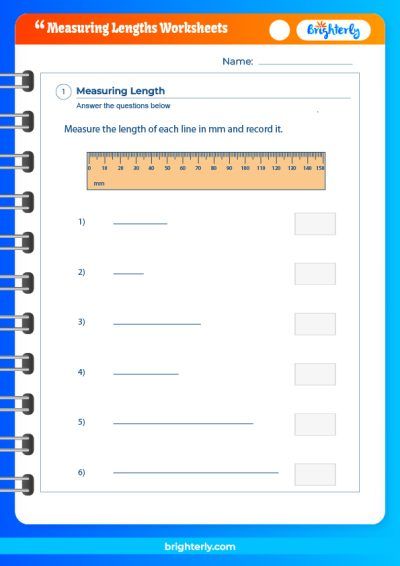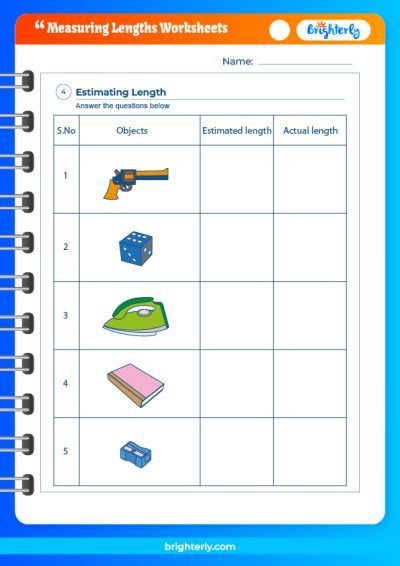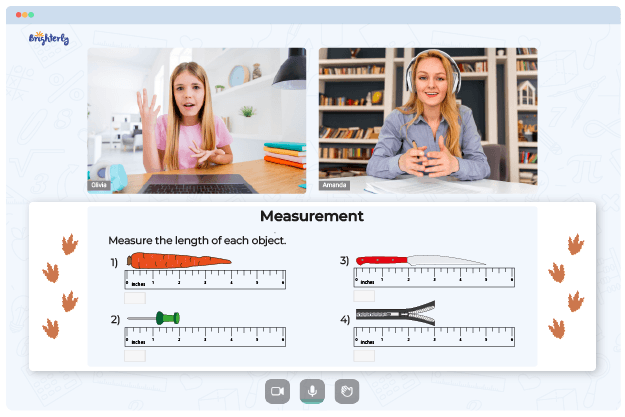Measurement of Length – Definition, Units, Examples
Updated on January 12, 2024
Welcome back, Brighterly family! As always, we’re thrilled to guide you on your thrilling adventure through the universe of mathematics. On today’s exploration, we’re going to unravel the mysteries of an everyday concept that connects us all, yet remains largely unnoticed – Measurement of Length.
From the tallest buildings to the smallest ants, the planets in our solar system to the thickness of your math book, everything around us has a measurable length. It’s this hidden concept that helps engineers design spectacular structures, athletes break records, and astronomers traverse the cosmos. So let’s leap into the world of length measurement together and see the magic that lies in plain sight!
What Is Length?
Let’s start our journey into the world of measurement by asking ourselves – what is length? In the simplest terms, length is the distance from one end of an object to the other. But, as is often the case in mathematics, there’s a whole world of wonder behind this seemingly simple concept. Length isn’t just a measure of how long something is, it’s a fundamental principle that shapes our understanding of the world.
Whether you’re a budding architect gauging the height of your future skyscrapers, an aspiring athlete tracking the distance of your sprint, or a future astronaut calculating the miles to Mars, length is at the heart of it all. It’s the unspoken language of the universe, helping us make sense of everything from the microscopic to the cosmic scale.
How to Measure Length?
Now that we know what length is, let’s understand how to measure length. At its core, measuring length is all about comparison. Imagine you’re in a race with your friends. How would you figure out who ran the fastest? By measuring the distance each of you travelled! Whether we’re baking our favourite cookies and need to measure ingredients, or we’re a carpenter building a house, we’re constantly measuring length, often without even realizing it!
But remember, the process of measurement is a bit like telling a story – the unit of measurement we choose can change the narrative. For example, expressing the distance to the next town in inches wouldn’t be very practical, would it? This is why understanding different units of measurement is so crucial.
You can find the solutions and additional exercises in our exciting Measurement of Length Practice Worksheets.
In the realm of measurement, practice truly does make perfect. That’s why we’ve crafted a comprehensive Measurement of Length Practice Worksheet, packed with a wide range of engaging exercises and brain-teasers. This worksheet is designed to help you cement the concepts we’ve covered in this post and push your understanding to new heights!
Units to Measure Length
When it comes to measurement, the world speaks in two primary languages – the metric and imperial systems. But before these systems came into play, people relied on non-standard units for their measuring needs.
Non-standard units of measuring length
Handspan
The handspan is one of the oldest units of length known to humanity. It’s the distance from the tip of your thumb to the tip of your little finger when you stretch your hand out wide. While everyone’s handspan is unique, it was a handy unit of measurement during ancient times when standard units didn’t exist.
Foot-span
Just like the handspan, the foot-span was another go-to unit of length. It was typically equal to the length of a person’s foot. But with the size of everyone’s foot being different, we needed a more uniform system. Enter, the standard units.
Standard units of measuring length
Metric System
The metric system is the superhero of the measurement world. Its superpower? It’s universal. The metric system uses units like the meter, centimeter, and kilometer, which are used and understood worldwide. This makes it incredibly practical for everything from scientific research to international travel.
Imperial System
The imperial system is the other main player in the measurement game. This system, which uses units like the foot, inch, and mile, is primarily used in the United States. Even though it’s not as widely used as the metric system, understanding it is essential for a well-rounded grasp of measurement.
Metric to Imperial System
Sometimes, we need to translate between these two measurement languages. Converting from the metric to the imperial system is just like translating words from one language to another. For instance, if you want to know how many inches make a centimeter, the answer is approximately 0.39 inches.
Imperial to Metric System
The same goes for conversions from the imperial to the metric system. For example, if you have a measurement in feet and need to know its equivalent in meters, you can use a conversion factor. 1 foot translates to about 0.3048 meters.
S.I. Unit of Length
In the world of science, we have a universal measurement language known as the International System of Units, or S.I. The S.I. unit of length is the meter, defined as the distance that light travels in a vacuum in 1/299,792,458 of a second. This definition ensures that regardless of where you are in the universe, a meter remains a meter.
Tools used for Measurement of Length
In our measurement toolkit, we have various tools suited to different tasks. These include:
- Rulers: These are typically used to measure lengths under one foot or 30 centimeters. They’re perfect for small tasks like measuring the length of your notebook.
- Tape Measures: These flexible tools can measure longer lengths, making them ideal for larger projects like measuring the size of a room.
- Meter Sticks: These are essentially long rulers, typically used in science labs for various experiments.
- Odometers: These devices, often found in vehicles, measure the distance traveled. They’re how we know how far we’ve driven!
Measurement of Length Chart
In our upcoming Measurement of Length Chart, we’ll help you make sense of all these units and conversions. We’ll provide you with a detailed overview of different units of length, from metric to imperial and vice versa.
Solved Examples on Measurement of Length
As always, we believe that learning is doing. So, we’ll put these concepts into practice with some solved examples on measurement of length. These hands-on exercises will help you understand the material better and make the learning process interactive and fun!
Practice Problems on Measurement of Length
And finally, to ensure that these concepts stick, we’ll provide some practice problems on measurement of length. Remember, practice makes perfect, and at Brighterly, we’re all about helping you reach your full potential! So get ready, grab your rulers, and let’s dive into the world of measurement together!
Conclusion
Just like every fascinating journey, our exploration of the Measurement of Length must come to an end. But don’t worry, there’s a whole universe of mathematical wonders still waiting for you on Brighterly! We hope you’ve enjoyed this voyage as much as we have and that you’ve gathered some valuable tools to navigate the world around you.
Whether you’re measuring ingredients for a delicious recipe, figuring out if your new desk will fit in your room, or just curious about the world, understanding length and how to measure it can open up a new way of looking at your surroundings. Remember, at Brighterly, we’re not just teaching math – we’re cultivating curiosity, fostering creativity, and encouraging exploration, one concept at a time.
As always, we’re here to answer any questions you might have. From your first handspan imperial system, our team at Brighterly is here to support your learning journey. Never hesitate to ask for help; there’s no question too small or too big when it comes to expanding your knowledge!
Continue exploring, stay curious, and remember – at Brighterly, we’re turning the ordinary into extraordinary, one math concept at a time. Remember that math is not just about numbers; it’s a universal language that helps us understand the world and the space we occupy. So, until our next thrilling adventure, keep measuring, keep discovering, and most importantly, keep enjoying mathematics!
Frequently Asked Questions on Measurement of Length
Here, we will address some frequently asked questions regarding the Measurement of Length. Each question is designed to expand your understanding and provide further insights into this fundamental concept.
Why do we measure length?
We measure length to understand the world around us better. From construction and engineering to everyday activities like cooking or travelling, measurements of length help us to quantify and compare different objects and distances.
What’s the difference between metric and imperial systems?
The metric system, used worldwide, is a decimal-based system that includes units like meters and kilometers. The imperial system, predominantly used in the U.S., measures length in inches, feet, and miles.
Why is the meter the S.I. unit of length?
The meter is the S.I. unit of length because it is based on universal physical properties. It is defined as the distance light travels in a vacuum in 1/299,792,458 of a second, ensuring consistency worldwide.
Information Sources
To further expand your knowledge, consider exploring these reputable resources:
- Britannica – Length
- National Institute of Standards and Technology (NIST)
- Physics for Kids – Units of Measurement
With Brighterly, every new concept is a chance to experience the beauty of mathematics. We can’t wait to embark on the next mathematical adventure with you!






